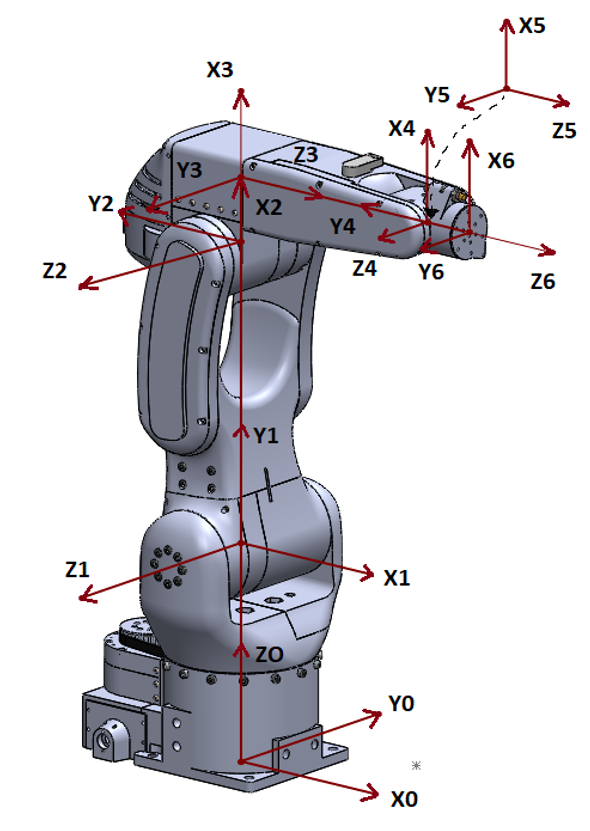Low level code¶
- Code is under MIT license: https://github.com/PCrnjak/Faze4-Robotic-arm/blob/master/LICENSE
- Matlab version used R2018a
- Robotic toolbox version: Robot-10.3.1
- Teensyduino version: Teensyduino, Version 1.53
- Teensy board used: 3.5
- Arduino IDE version: 1.8.13
Tip
You can scrap this code for parts and write much better code.
These codes are just proof of concept and must be handled with caution
Code for this robotic arm can be devided in 2 parts:
- Low level code
- High level code
Low level code is code that runs on our microcontroller (in our case teensy 3.5). Its main purpose is to receive information from high level code and transform that information into useful signals for stepper drivers. That is a gross simplification, but codes used will be explained in more detail below.
All code is in github repository.
Tennsy environment setup¶
Install arduino IDE: https://www.arduino.cc/en/main/software
Download Teensyduino from here: https://www.pjrc.com/teensy/td_download.html
Teensyduino is a software add-on for the Arduino software.
Teensy low level code for testing in Matlab(live script)¶
Tip
You can scrap this code for parts and write much better code.
File is located at: Faze4-Robotic-arm/Software1/Low_Level_Arduino/Arduino_GUI_code.ino
It works together with Matlab code located at: Faze4-Robotic-arm/Software1/High_Level_Matlab/GUI_Matlab.mlx
In first 100 lines are pin definitions. They are made for first version of faze4 distribution board that is now legacy and is replaced with second version that is also on sale here: * https://blestron.com/product/faze4-connector-boarad/
When power is applied to robot it will first perform homing routine. After all joints are homed it will go to starting/start by postion. After that it is ready to receive data from Code located in: Faze4-Robotic-arm/Software1/High_Level_Matlab/GUI_Matlab.mlx
Program is actually really simple. After homing we get data from matlab or any other source and then move robot according to that data. As you can see in code bellow we call only 2 functions in main loop.
1 2 3 4 5 6 7 8 | void loop() {
while (error == 0) {
get_data();
move_all();
}
}
|
But before we get to main loop robot needs to home. Now if robot starts moving away from its limit switches during homing you need to stop it and do one of 2 things:
- Switch stepper motor phases
- change direction in software
After robot homes it goes to standy/start position.
In main loop move_all(); is based on functions like this:
1 2 3 4 5 6 7 8 9 | if (needed_position[joint[1]] > current_position[joint[1]] ) {
digitalWrite(dirPin[joint[1]], LOW);
move_routine_forward(joint[1]);
}
else if (needed_position[joint[1]] < current_position[joint[1]] ) {
digitalWrite(dirPin[joint[1]], HIGH);
move_routine_backward(joint[1]);
}
|
What this snippet does is this: Code is always looping thru this code in main loop. If needed_position is same as current_position nothing happens. If it is different we check if it is smaller or bigger and on those terms move_forward or move_backward. Then we perform same code on all joints of robot arm.
Move routine works like this:
1 2 3 4 5 6 7 8 9 10 11 12 13 14 15 16 | void move_routine_forward(int joint_num) {
currentMillis = micros();
#state is used to prevent triggering of this if statement twice in row
#same goes for second one , this secures perfect square wave form
if (currentMillis - previousMillis[joint_num] >= current_pulse_widht[joint_num] and state[joint_num] == 0) {
previousMillis[joint_num] = currentMillis;
digitalWrite(stepPin[joint_num], HIGH);
state[joint_num] = 1;
}
else if (currentMillis - previousMillis[joint_num] >= (current_pulse_widht[joint_num]) and state[joint_num] == 1) {
previousMillis[joint_num] = currentMillis;
digitalWrite(stepPin[joint_num], LOW);
state[joint_num] = 0;
current_position[joint_num] = current_position[joint_num] + 1;
}
}
|
One step of stepper motor is defined by change from high to low signal on step pin. speed is defined by length of that signals period. In this code we use micros as timer function. Lets say we want half period of our pulse to be 500 us. Once we see 500us or more passed we switch step pin to HIGH and move state variable to low. We move that variable low as an indicator that next 500 us will swtich pin to LOW. Now when we switch to LOW state goes to 0 and we increment current position +1. This proces goes until move_all(); see that current_position = needed_position.
Now in normal operation robot can never hit limit switches if it hits them error variable in main loop goes to 1 and robot locks. This is done as a simple safety feature. But it can be disabled by just removing that while (error == 0) loop.
1 2 3 4 5 6 7 8 | void loop() {
while (error == 0) {
get_data();
move_all();
}
}
|
Teensy low level code for Matlab trajectory planning¶
File can be found here: Faze4-Robotic-arm/Software1/Low_Level_Arduino/Robot_Arduino_trajectory/Robot_Arduino_trajectory.ino Code is almost the same only thing that is done differently is protocol for sending and receiving data is a bit more complex.
